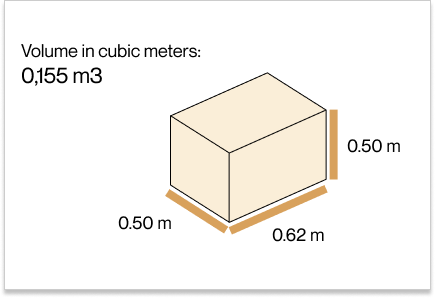What is shipping weight?
Carriers price their shipments according to the carrying weight. The tare weight is not necessarily the same as the actual weight of the goods.
All carriers price their transports according to "chargeable weight" and the chargeable weight is not necessarily equal to what your goods actually weigh. This may sound complicated. We'll try to explain and make it clear!
Good to know: Sendify automatically calculates the shipping weight in connection with your shipping search and always shows the shipping cost based on the shipping weight. You don't have to think about this! Provided you enter the dimensions and weight correctly in the search.
A truck is limited by both size and weight, therefore the freight cost is affected by both the dimensions and weight of what you send. It is therefore important that you enter both weight and dimensions as accurately as possible. If you are unsure, we recommend that you add a little margin.
The shipping weight is the higher of the actual weight or the dimensional weight, and the price of a shipment is always set based on the higher of these two values.
Below we explain the difference between Actual Weight and Dimensional Weight:
1. Actual weight
- The weight in kg that the goods actually weigh.
- The weight you enter when you book.
- It is important that the pallet or packaging of the shipment is included in the weight you enter when booking.
2. Dimensional weight
- For parcels and stackable goods
- Volume weight: first calculate the cubic meter of your shipment. Take this multiplied by the carrier's factor (see factor below depending on who the shipment is booked with).
- For non-stackable goods (often pallets)
- Unit weight: The unit weight is usually used when the goods are not stackable and corresponds to the area that the goods take up on the truck bed. The calculation for flatbed meters is as follows: Length x Width / 2.4 meters.
To calculate the volume weight, carriers use different factors, but what they have in common is that they calculate the cubic meters of the goods and multiply it by a weight.
How does it work in practice - An example calculation
1 package x (62.00, 50.00, 50.00) @ 19.00 kg
- Convert the measurements to meters:
62.00 x 50.00 x 50.00 → 0.62 x 0.5 x 0.5 - Volume in cubic meters :
0.62 x 0.5 x 0.5 = 0.155 m3

You ship with DHL Domestic:

Then the actual weight (19 kg) is compared with the volume weight (43.4 kg). Here the freight will be charged according to the volumetric weight when it is highest.
Sendify calculates both weights automatically when you do a search and displays the price in the same way as the carriers. You don't have to worry about this as long as you enter the weight and dimensions of the shipment correctly, and indicate whether the goods are stackable or not.
Packages are always considered stackable by carriers.
Did we not answer all your questions?
Drop us a message in the chat and we will help you! 🌟